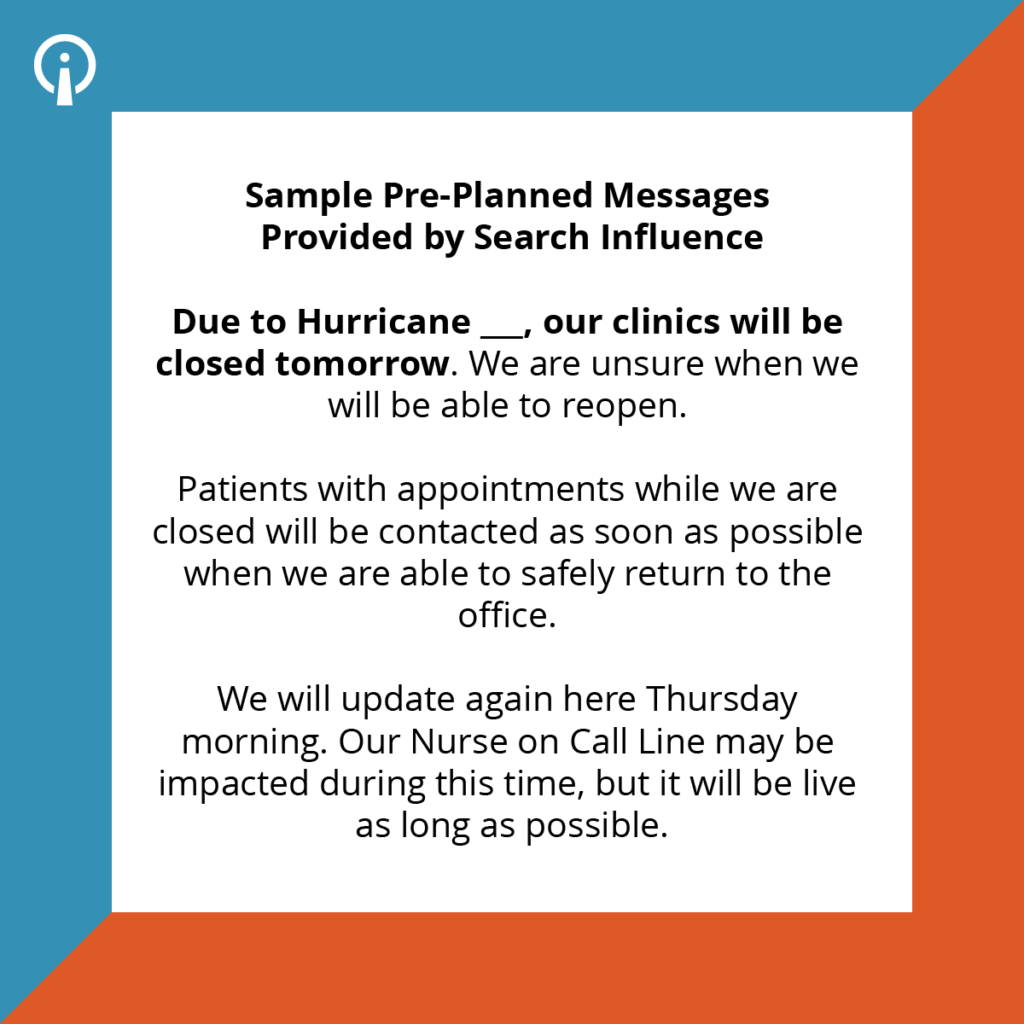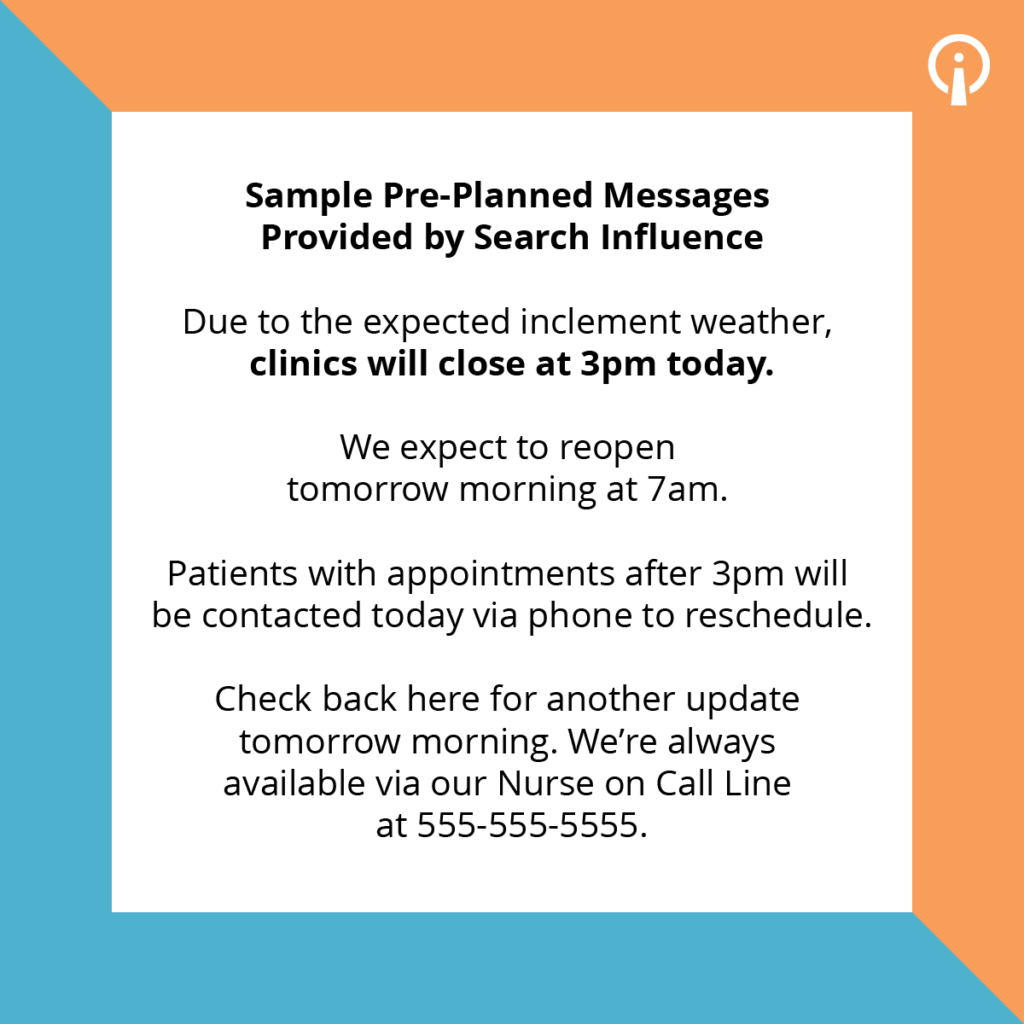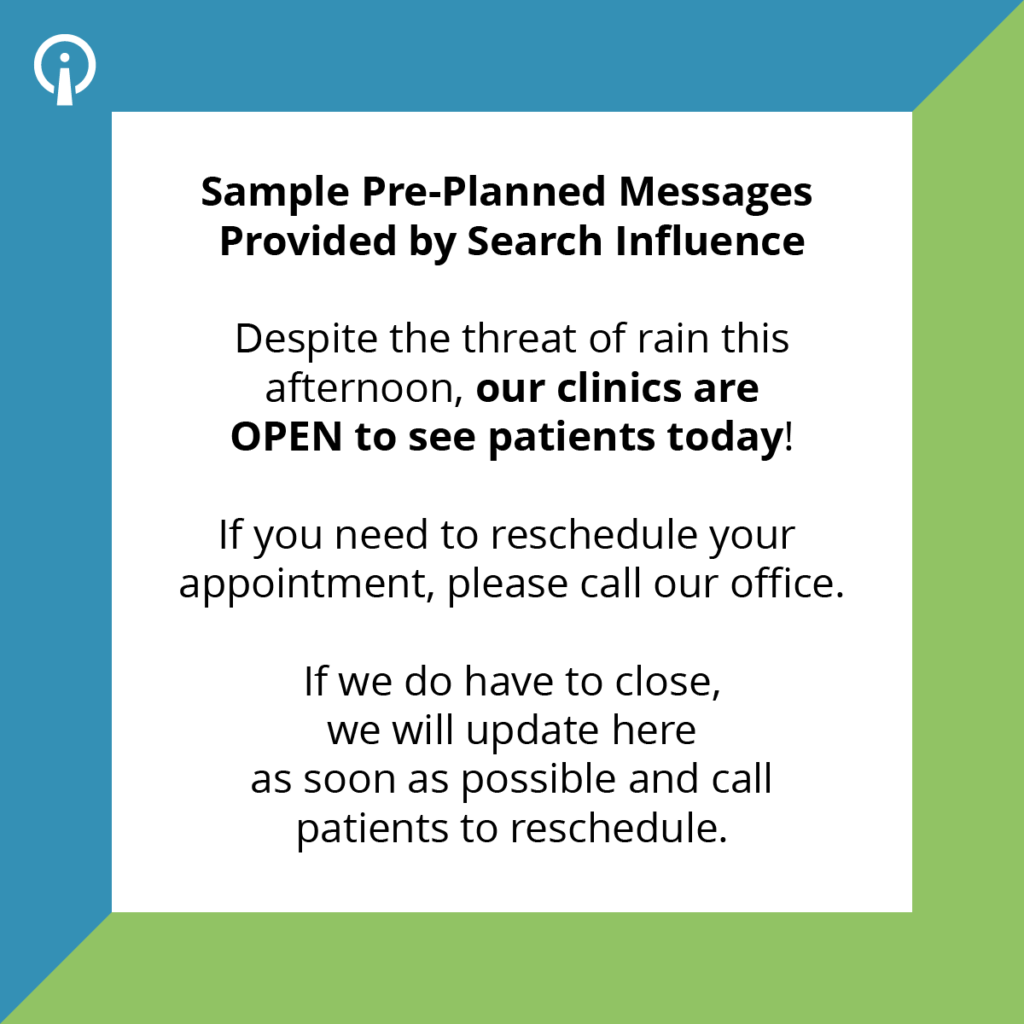Healthcare Marketing Ideas: How to Communicate Through Severe Weather Events
July 5th, 2022 by
Key Insights
- Unexpected events are just that — unexpected. Despite this, your healthcare practice can properly prepare for any unprecedented conditions by remaining proactive in pre-planning patient/provider communication strategies.
- Keep your messages in touch with current events. Adjust automated and pre-scheduled messages, social media posts, and newsletters to fit the context of the current climate. In other words, don’t be tone-deaf!
- In times of uncertainty, keep patients informed by reviewing all digital platforms for opportunities to regularly send out updates. No site or profile is too small for an update regarding office closures or changes to your hours of operation.
- Keep messages, details, and updates across platforms accurate. There’s no quicker way to lose a patient’s trust than to send out information that seemingly contradicts itself.
- Pre-planning communication strategies help your team save time, delegate responsibilities, and understand expectations when weather or pandemic-related events strike. It’s never too soon to start pre-planning your medical marketing strategies to circumvent a potential crisis.
Picture this — it’s the height of a worldly crisis, and your healthcare clinic has no choice but to temporarily close its doors to patients. You’re rushing to get your office’s updates written, approved, and posted, on top of trying to figure out which marketing team member will update which platforms to keep patients informed and engaged with your clinic. You haven’t even decided how to release your updates, and you’re already overwhelmed.
This scramble to release timely, accurate, and relevant information to the public signals the need for your team to plan cohesive communication strategies. Proactive communication — as opposed to reactive responses — helps anticipate what your patients most want to know, as well as how and when they prefer to receive updates regarding your facility.
From adjusting automated messages and updating your office’s primary platforms to enhancing reader trust through accurate messaging, pre-planning your medical marketing strategies contributes to a more confident and patient-centered workflow. In this post, we’ll cover some healthcare marketing ideas to drive effective patient/provider communication during unpredictable times.
Benefits of Proactive Communication for Patients and Staff
No matter if your clinic is bracing for the rampaging effects of a Category 3 hurricane or a global pandemic, environmental threats are a direct segway to stressed hospital systems. Unexpected events and catastrophes often lead to last-minute office closures, causing an increase in delays in care and, ultimately, a decline in provider satisfaction. On the contrary, if your office remains open while other healthcare clinics in your area face closures, front desk staff may field relentless phone calls from patients inquiring about your hours of operation and whether they should even show up for their appointment.
If you communicate proactively, you may be able to increase your show rate for those uncertain days and prevent less rescheduling — which can otherwise be a headache for staff and doctors alike. Streamlining communication between patients and staff begins with implementing agile practices in otherwise turbulent environments. In doing so, not only is patient experience improved, but care staff can relish the efficiencies of a more seamless and adaptive work environment.
Once your patients trust that your digital platforms will provide them with critical information, you’ll start to really see these benefits. But to reap these rewards, your team will first need to adopt strategies that center your clinic as a reputable and dependable source of information.
Adjust Automated and Pre-scheduled Messages
We live in an automated world — pre-scheduled posts and emails help us run our marketing communications smoothly on a daily basis. So, what can you do to make sure that automation doesn’t hurt your brand? If patients receive or see messages contradictory to what they expect or heard through another channel, they may question what is accurate. During a crisis, adjusting all pre-planned messages before they reach your intended audience is the backbone of consistent and reliable patient-provider communication.
Halt automated messages
Your team is likely already in the habit of updating your office’s phone tree. Beyond that, your team should be turning off any automated appointment reminders. If a patient receives a message while the office is closed, that can cause questions regarding whether they have missed an important appointment — reducing their confidence in the communication they are receiving.
Reevaluate pre-scheduled posts, emails, and newsletters
Next, you should review any pre-scheduled social media posts and defer or cancel any that would appear tone-deaf or not make sense given the current climate. Even if it’s an engagement-driven evergreen post, if your audience sees that while they are in the middle of a natural disaster, it may look like your company isn’t paying attention to what’s going on in the world.
The same principle applies to marketing emails or newsletters that you may have pre-scheduled or that go out on an automated cycle; if patients receive those during a time of crisis, then the messages will, at best, fall on deaf ears and not get the attention they deserve. In a worst-case scenario, they could insult a patient who might wonder why they are receiving an email about a non-timely topic during an emergency situation. No matter the type, reviewing and adjusting all pre-scheduled messages prevents the likelihood of insensitive content surfacing and tainting your brand’s empathetic reputation.
Update Information on Primary Platforms
Now that you’ve covered the basics and paused any messaging that may not make sense to your receivers, it’s time to shift focus to where patients might expect to find pertinent information. According to a survey conducted by Redpoint Global, a staggering 80% of patients report preferring to use digital channels to communicate with healthcare providers at least part of the time, which highlights the criticality of keeping digital content updated across all online platforms.
To begin, you’ll want to review your healthcare system’s most influential platforms to suggest any updates be made to hours of operation, facility safety standards, or other relevant expectations patients may expect to have. While the breadth of your digital footprint may be more than you realize when first building a list of profiles to update, some of the most important platforms that will require reviewing include:
- Your website
- Email/text
- Patient portal
- Google My Business
- Google Search
- Any other websites that come up when someone searches your hospital or medical office’s name
Install a website notification bar
If you don’t already have a website notification bar, it’s a good idea to install a feature that puts a banner at the top of your site with your clinic’s latest updates. Before using this functionality, your team should be sure to complete a test run on your site to ensure it accurately delivers timely notifications. Because your staff may be limited in emergency or last-minute scenarios, it’s also important that 2-3 team members are trained and have access to update this, as well as create a new page with more details if necessary.
Assure Patient Confidence With Accurate Messaging
How can you assure your patients trust the information you’re delivering in the updates? Establish confidence in the accuracy of your messages by:
- Dating the updates: Keeping a time record of updates helps your patients know the information you’re putting out is fresh. This can be especially important if the situation lasts longer than a day or two.
- Communicating often: Keep the updates coming. Daily updates may make sense on some channels, particularly in the days of the most uncertainty.
- Keeping it consistent: Be sure the messages and details across each platform refrain from contradicting one another. Consistent messaging is key to long-standing patient trust!
- Being clear about patient expectations: Don’t make your patients assume — proactively communicate what they can expect from your staff and clinic.
- Relaying information about future updates: Finally, note when and how patients can receive the next update.
Strategies to Pre-plan
So, you’ve reevaluated all automated and pre-scheduled messages, updated your primary platforms with accurate information, and now you’re looking at how to pre-plan your medical marketing strategies in times of crisis. Some of the most essential components of an effective pre-plan strategy include:
- Delegating responsibility for updating platforms: Be sure there are 1-2 backups, just in case a staff member isn’t in a location with reliable internet access.
- Implementing a shared password system: Store passwords in a secure management system like Passpack or Last Pass to ensure that the right people have access to the proper channels for updating.
- Writing and gaining approval for sample messages: Sample messages can be used as a basis for your real-time messages and demonstrate the most important points of all of your healthcare marketing ideas. This strategy can help save your team writing time while also ensuring communications get out quickly.
- Pre-creating social media graphics and email templates: Just like pre-writing sample messages, pre-creating graphics and emails accompany the same benefits of saving your staff time in periods of urgency.
- Carrying out a crisis communication drill: Take an hour or two to present a scenario to your team and have them “execute” the plan all the way up until posting or sending any messaging. This will pressure test if they are able to write the messages, access the platforms, and work the relevant systems. It will also force all the pre-organization to happen by making sure everyone has access to the plan.
Anatomy of pre-planned messages
Whereas we may be quick to assume communication is solely required for office closures, it’s almost equally as important to communicate that you are open if things are happening in your community that may be causing others to close. Ideally, pre-planned messages for office openings and closures are composed using the following anatomical focal points:
- What’s the situation?
- How are hours impacted?
- How will existing appointments be handled?
- When can patients expect the next update?
- How can patients be helped while you are closed
So, How Do You Get Started?
With hurricane season fully underway and COVID-19 numbers still on the rise, now is the time to enact these medical marketing strategies and meet your business growth goals. Here’s a quick recap on how to get started:
- Establish and gather your team of 2 or 3 people minimum so that you have coverage.
- Compile and prioritize the list of communication channels and platforms. Then, define owners and set up access, logins, and training.
- Pre-plan messages and get those approved.
- Finally, conduct drills to make sure your team can execute the plan as intended without any preventable basic issues.
Now that you’ve mastered the basics of proactive healthcare communication strategies, it’s time to set your plan into motion. At Search Influence, our digital marketing agency can help you create a communication plan that keeps your patients informed, engaged, and returning. To learn more, contact us today for help getting started on all of your healthcare marketing ideas.





